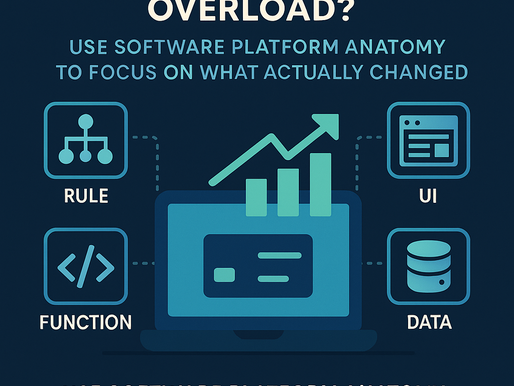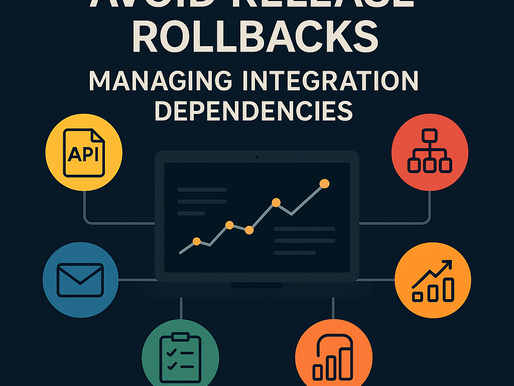top of page
Enterprise Intelligence
Transforming Strategy into Execution with Precision and Real Intelligence


Why Software Teams Still Mistake Tools, Buzzwords, and Diagrams for Architecture
The Sunil (ICMG) – Sean / Shyam (Name changed for privacy) Exchange. This interaction highlights a recurring pattern among software development teams — where the concept of “Architecture” is reduced to tool usage, buzzwords, templates, and a handful of diagrams, instead of being understood as a model of enterprise anatomy.

Krish Ayyar
Nov 16


Case SPA U14: Custom UIs and Logic, One Core System? How Software Platform Anatomy Enables Scalable Variants 💲
Custom Screens. Custom Logic. One Core System.Your platform serves dozens of institutional clients. Each has:A different onboarding screen. Custom eligibility rules.Branded dashboards. Specialized workflows for approval or document upload. Yet underneath, it’s the same product. When it’s time for a platform release: One client’s change breaks another’s UI. A shared component fails due to unexpected variant behavior. o

Krish Ayyar
Jul 13


Case SPA T21: Regression Testing Overload? Use Software Platform Anatomy to Focus on What Actually Changed
It’s the week before release. The build is ready, and everyone’s proud of how a new risk rule was introduced to tighten underwriting. But the QA team drops a bomb: “We need to re-run 700 regression tests. We can't isolate the impact.” Test cases are duplicated. Environments are blocked. Delivery is delayed—not because of failure, but because no one can say what actually changed and where it matters.

Krish Ayyar
Jul 10


Case SPA O17: Mid-Project Strategy Change?Software Platform Anatomy Keeps the Architecture Calm
It’s week seven of a twelve-week release cycle.
You’re midway through a platform upgrade for a lending product when the call comes in from the executive floor:
“We’re pivoting. Risk appetite has changed. Drop the premium variant—focus on small-ticket, high-frequency loans instead.” Silence. Then panic.

Krish Ayyar
Jul 10


Case SPA O18: From Rewrites to Reusability: How Software Platform Anatomy Guides Sustainable Platform Evolution
It starts with a single sentence.“We’re thinking of rewriting the eligibility engine.”Nobody’s surprised. It’s been said before. Too many branches. Too much conditional logic. “We can build it better this time.”The architects start scoping. Developers look relieved. Business teams are cautiously hopeful.

Krish Ayyar
Jul 9


Case SPAU15: Why Releases Break When Requirements Change Late—And How Software Platform Anatomy Keeps You on Track
Late requirements are a fact of enterprise life—especially in retail lending.But architectural confusion, delivery slippage, and post-release rollback?Those are avoidable.With the ICMG Software Platform Anatomy, you don’t just build a system—you build a model that absorbs change and keeps your release on track.

Krish Ayyar
Jul 9


Case SPA N11: Tech Stack Shifting Again? How Software Platform Anatomy Maintains Architectural Integrity
“We’re Migrating Again... What Could Possibly Go Wrong?” Your architecture team announces. “We’re switching to a new event streaming platform.”“We’re moving from REST to gRPC for internal services.”“We’re adopting a new message format for credit bureau APIs.”
Everyone nods until Environments break, Legacy subsystems go out of sync., Support tickets spike.

Krish Ayyar
Jul 8


Case SPA N12: Avoid Release Rollbacks—How Software Platform Anatomy Tracks and Manages Integration Dependencies
The Release Was Green—Until It Hit the Integration Wall. You’ve completed your regression testing. All environments are go. The release deploys cleanly. Then, within minutes: Partner bank API throws an unknown schema error.The credit bureau integration returns a deprecated response.
Internal logs show mismatched event payloads.
The result? A full rollback. Again.

Krish Ayyar
Jul 8


Case SPA F6: Handling Policy Restructuring Under Pressure? Use Software Platform Anatomy for Coordinated Execution
Retail lending is policy-driven. Every month brings updates to scoring, pricing, eligibility.Most teams treat it as fire-fighting. But with ICMG Software Platform Anatomy: Rule changes are modeled, not buried. Component impacts are visible, not guesswork. Cross-team coordination is structured, not sprint chaos. You don’t just restructure policy. You execute it—without system panic.

Krish Ayyar
Jul 6


What Most CIOs Don’t Realize - Inside IT, No One Built the Architecture 💲
But in reality, what’s often called “IT architecture” is little more than a catalog of tools, infrastructure layers, and governance slides. What’s missing is structure (anatomy).
Not documentation — but a functional blueprint how it works.

Sunil Dutt Jha
Jul 4


Mistaking IT Integration vs. Enterprise Integration: The Fundamental Problem with IT Architects
If IT alone genuinely delivered enterprise-wide integration, why do thousands of employees still spend millions of manual working hours

Sunil Dutt Jha
Mar 7


ICMG IT Architecture Mastery Program: From Myths to Strategic Execution
Through this journey leaders will shift their focus from short-term implementation fixes to remain competitive, efficient and resilient.

Sunil Dutt Jha
Feb 19


The Balcony vs. The Building: The Problem with Project-Based Architecture
Instead of implementing a balcony within the existing structure, teams start designing an entirely new building. The result?

Sunil Dutt Jha
Feb 3


Enterprise Ratings: Lessons from Evaluating 12 Large-Scale Projects for a Leading Travel Platform
With their technological scale & global reach, they assumed their project architectures were robust, \but the results told a different story

Sunil Dutt Jha
Feb 2


Case Study: Transforming Retail Lending with Anatomy-Driven IT Architecture
In this case study, we explore how a retail lending platform is transformed from conventional, tool-centric to anatomy-driven architecture

Sunil Dutt Jha
Jan 11


Lessons from Construction: Why IT Architecture Needs a Blueprint
As complexity in increased, the role of civil architects transitioned from optional to essential. The same is true for IT systems today

Sunil Dutt Jha
Jan 11


One Anatomy for Every Project and Product: The Key to IT Alignment
It states that the every project has same building blocks—Goals, Processes, Systems, Components, implementation, and operation

Sunil Dutt Jha
Jan 11


Managing Complexity with Project and Product Anatomy: The Retail Lending Example
From managing intricate workflows to integrating multiple systems, the ability to handle complexity effectively is critical

Sunil Dutt Jha
Jan 11


The IT Architecture Myth: Breaking Free from Outdated Beliefs
To drive meaningful change, we need to break free from outdated beliefs and embrace a holistic, strategic approach to architecture

Sunil Dutt Jha
Jan 11


The Myth of Microservices: Why Microservices Alone Don’t Define Architecture
While microservices are a valuable programming design pattern, they are not architecture.

Sunil Dutt Jha
Jan 11
bottom of page
